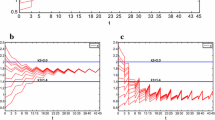Abstract
In this paper, we formulate a mathematical model for a continuous delayed single-species population with impulsive state feedback control. We give the existence and uniqueness of the order-1 periodic solution in view of successor function. At the same time, the stability of the order-1 periodic solution is proved by means of Huang et al. (Nonlinear Dyn 90:1–9, 2017). Finally, some results are justified by some numerical simulations.







Similar content being viewed by others
References
Anguelo, R., Dufourd, C., Dufourd, C.: Mathematical model for pest-insect control using mating disruption and trapping. Appl. Math. Model. 52, 437–457 (2017)
Tian, Y., Zhang, T., Sun, K.: Dynamics analysis of a pest management prey–predator model by means of interval state monitoring and control. Nonlinear Anal. Hybrid Syst. 23, 122–141 (2017)
Sun, K., Zhang, T., Tian, Y.: Dynamics analysis and control optimization of a pest management predator–prey model with an integrated control strategy. Appl. Math. Comput. 292, 253–271 (2017)
Liang, J., Tang, S., Cheke, R.A.: Beverton–Holt discrete pest management models with pulsed chemical control and evolution of pesticide resistance. Commun. Nonlinear Sci. Numer. Simul. 36, 327–341 (2016)
Sun, K., Zhang, T., Tian, Y.: Theoretical study and control optimization of an integrated pest management predator–prey model with power growth rate. Math. Biosci. 279, 13–26 (2016)
Zhang, S., Zhang, J., Men, X., Zhang, T.: Geometric analysis of a pest management model with Hollings type III functional response and nonlinear state feedback control. Nonlinear Dyn. 84, 1529–1539 (2016)
Macphersona, M.F., Kleczkowski, A., Healey, J.R., Quine, C.P., Hanley, N.: The effects of invasive pests and pathogens on strategies for forest diversification. Ecol. Model. 350, 87–99 (2017)
Jeger, M.J., Xu, X.-M.: Modelling the dynamics of a plant pathogen and a biological control agent in relation to flowering pattern and populations present on leaves. Ecol. Model. 313, 13–28 (2015)
Jackson, M., Chen-Charpentier, B.M.: A model of biological control of plant virus propagation with delays. J. Comput. Appl. Math. 330, 855–865 (2018)
Ghosh, B., Grognard, F., Mailleret, L.: Natural enemies deployment in patchy environments for augmentative biological control. Appl. Math. Comput. 266, 982–999 (2015)
Klein, T., Zihlmann, D., Derlon, N., Isaacson, C., Szivak, I., Weissbrodt, D.G., Pronk, W.: Biological control of biofilms on membranes by metazoans. Water Res. 88, 20–29 (2016)
Pang, G., Chen, L.: Periodic solution of the system with impulsive state feedback control. Nonlinear Dyn. 78, 743–753 (2014)
Liu, Q., Huang, L., Chen, L.: A pest management model with state feedback control. Adv. Differ. Equ. 2016, 292–303 (2016)
Smith, F.E.: Population dynamics in Daphnia magna and a new model for population growth. Ecology 44, 651–663 (1963)
Chen, L., Liang, X., Pei, Y.: The periodic solutions of the impulsive state feedback dynamical system. Commun. Math. Biol. Neurosci. (2018). https://doi.org/10.28919/cmbn/3754.14
Connell McCluskey, C., Muldowney, J.S.: Bendixson–Dulac criteria for difference equations. J. Dyn. Differ. Equ. 10, 567–575 (1998)
Huang, M., Chen, L., Song, X.: Stability of a convex order one periodic solution of unilateral asymptotic type. Nonlinear Dyn. 90, 1–9 (2017)
Author information
Authors and Affiliations
Corresponding author
Additional information
Publisher's Note
Springer Nature remains neutral with regard to jurisdictional claims in published maps and institutional affiliations.
This work is supported by the National Natural Science Foundation of China (No. 11371164), NSFC-Talent Training Fund of Henan (U1304104), innovative talents of science and technology plan in Henan Province (15HASTIT014) and Key Scientic Research Project of High Education Institutions of Henan Province (17A110026).
Rights and permissions
About this article
Cite this article
Chen, Y., Zhao, Z. Mathematical model for continuous delayed single-species population with impulsive state feedback control. J. Appl. Math. Comput. 61, 451–460 (2019). https://doi.org/10.1007/s12190-019-01253-2
Received:
Published:
Issue Date:
DOI: https://doi.org/10.1007/s12190-019-01253-2
Keywords
- Continuous delayed single-species population
- Food-limited model
- Order-1 periodic solution
- Impulsive state feedback control




